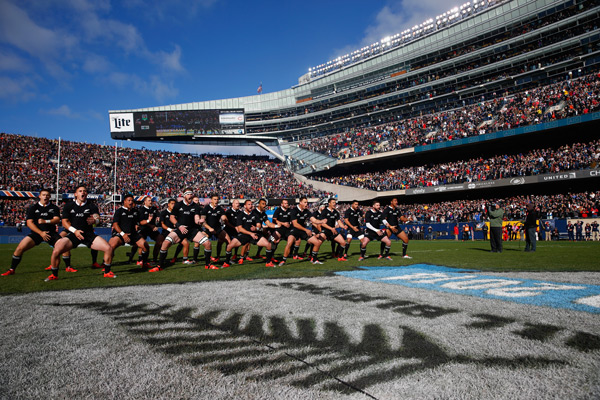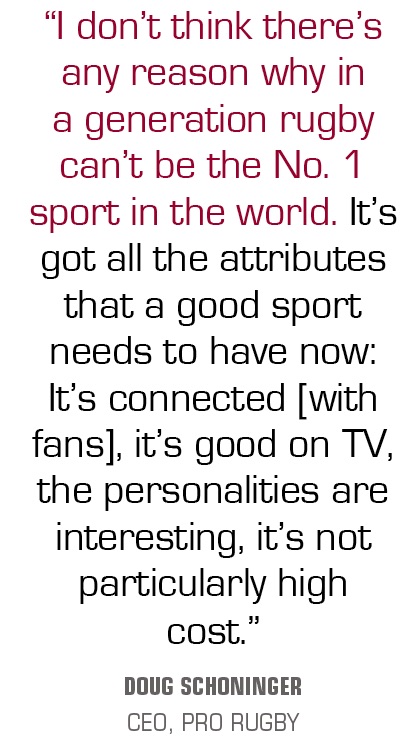In November 2014, USA Rugby hosted an international test match against the New Zealand All Blacks at Soldier Field in Chicago. The result on the field, a 74-6 drubbing by the visitors, was not a surprise. But the attendance was a stunner: A 61,500-seat sellout, tripling the previous high-water mark for a rugby audience in the U.S.
Since then, a few more rugby special events have drawn good crowds, and in 2016, the sevens version made its Olympic debut. Meanwhile, NBC Sports has steadily added rugby to its programming, a big step for a game that was practically invisible in America just a generation ago.
All this activity has made a small but passionate group of businessmen certain that the sport is ripe for commercialization, and they’ve put millions of dollars into their efforts to build an American rugby industry. Their enthusiasm starts with the sport’s high-income fan base of ex-players and immigrants, and grows with the belief that they can gain new followers by leveraging the game’s constant action and fast pace, along with anxiety over the dangers of American football.
But their unity of spirit has been hindered by strategic and personal disagreements, high-profile failures and fierce competition for what is, by all accounts, still a very niche market.
Today, at least five groups of entrepreneurs are trying to launch U.S.-based professional leagues in an era when even established, major-sport leagues face profound challenges in keeping fans’ attention.
 |
A New Zealand All Blacks-Team USA match in 2014 sold out Chicago’s Soldier Field, offering a glimpse of rugby’s potential in the U.S.
Photo by: GETTY IMAGES
|
The clutter is partly intrinsic to rugby, a game with two very distinct versions (seven-man and 15-man), but it’s also a reflection of profound differences of opinion on a key question: build a pro league now, or focus on more limited, lower-risk efforts to build awareness of the sport over the long term?
“I don’t think there’s any reason why in a generation rugby can’t be the No. 1 sport in the world,” said Doug Schoninger, a former bond trader who launched the PRO Rugby league in 2016 but is now struggling to get a second season off the ground. “It’s got all the attributes that a good sport needs to have now: It’s connected [with fans], it’s good on TV, the personalities are interesting, it’s not particularly high cost.”
But other marketers think a true league is too ambitious for the time being, and are instead focusing on annual tournaments and one-off showcases.
TLA Worldwide, which helped promote the 2014 game at Soldier Field and the U.S.-Ireland match last weekend in Harrison, N.J., evaluated opportunities in international sports a few years ago and loved what it saw in rugby. “We’re very bullish on rugby in the States,” said CEO Michael Principe. But TLA believes promoting one-off events with recognized international brands is the best path for now.
“The market’s still developing, and for a league to be successful, you need strong sponsorship, strong media and strong grassroots support,” Principe said. “And when all those three come together, the conditions are right for league play.”
The leagues face long odds, said Bob Caporale, founder of the investment banking and consulting shop Game Plan.
“The sports market in the U.S. is not just the U.S. anymore,” said Caporale, who does not have any rugby investments. “If you’re a soccer fan, you can watch on your television Premier League soccer games, and that just adds to the already existing proliferation of sports leagues we have. … And so to start a new pro league, you have a tremendous amount of — I don’t want to call it competition — I would just call it distraction.”
■ ■ ■ ■
Stakes are high. Nobody wants to get it wrong, lest it poison the well for everybody. And there are nearly as many different strategies as there are investors.
Schoninger’s league, PRO Rugby, played a season of 15s in 2016, but its future is in jeopardy after it canceled player contracts in December amid a dispute with USA Rugby. The four other would-be leagues — Major League Rugby (15s), the National Rugby Football League (15s), Grand Prix Rugby Football League (sevens) and the North American Super 7s Rugby League — say they’re within two years of launching (see related story). Meanwhile, rumors persist in the British media that Pro12, a European 15s league, wants to expand into the U.S.
In the meantime, TLA, NBC Sports and AEG are all continuing with lower-risk plans to keep rugby in the American public eye. Later this year, as part of a recently announced four-year deal with AEG, the English Premiership will play a regular-season contest between the Newcastle Falcons and Saracens FC at Talen Energy Stadium in Philadelphia.
Rugby International Marketing, the for-profit arm of USA Rugby, has issued sanctions to two of the pro leagues but has seen far more tangible results to date in commercializing international friendlies and tournaments, including selling title sponsorship to Emirates for the two-game “Summer Series,” made up of the Ireland match and a game versus Georgia on June 17. RIM was founded with minority partners CSM Sport & Entertainment, Rugby Football Union and the British Premiership side Harlequins FC.
One company, United World Sports, is pursuing both a league and other strategies. It invented Super 7s, a proposed league in a modified form of sevens, but it’s also promoting and developing recurring rugby events. It’s seen success with its owned properties, such as the Penn Mutual Collegiate Rugby Championship, just completed in Philadelphia on June 4, and the annual Las Vegas stop on the World Rugby-owned HSBC Rugby Sevens Series, for which it owns commercial rights.
UWS executives say they’ll launch a new sevens tournament at Avaya Stadium in San Jose on Nov. 4-5, the Silicon Valley Sevens, which will involve national squads before they start the international sevens circuit. President Jonathan First thinks annual tournaments are the best way to build his company’s value and the sport’s fan base.
“It’s an emerging sport,” First said, “and it’s still viewed by the American consumer in general as a foreign sport. It’s going to take awhile.”
■ ■ ■ ■
Despite the words of caution, there’s good reason to believe in rugby’s potential.
U.S. participation has grown, on average, 13 percent annually since 2011, and its players are far more likely to hold advanced degrees and earn more than $100,000 than the average population, according to the Sports & Fitness Industry Association. It’s the fastest-growing team sport measured by the SFIA. Amid China’s emergence and the ongoing success of U.S. broadcasts of international soccer, it’s got a desirable international flavor, too.
American rugby events with a track record, like the Penn Mutual Collegiate Rugby Championship, have steadily grown attendance and NBC clearly thinks it has a future on TV. “We’re very happy about how it performed in the Olympics,” said Jon Miller, NBC Sports programming president.
The sport’s biggest proponents like to call it the next soccer, but there are big differences.
When Major League Soccer formed in 1993, ahead of its 1996 launch, youth and scholastic soccer programs were commonplace throughout the country. In 2016, only 61 high schools in the country fielded an organized rugby team, according to the National Federation of State High School Associations. Also, rugby enthusiasm is heavily concentrated in California and the mid-Atlantic, and in Irish or British commonwealth ex-pat communities.
Investors are bound to see the shortcomings, Caporale said. “I don’t think you can sell it, if you will, to anyone who isn’t already interested in the sport,” he said. “It’s too far down, if you will, on the list. Maybe friends and family, but I think it’s hard.”
Rugby proponents are counting on the 2018 Rugby World Cup Sevens, to be held in San Francisco in July 2018, to do for pro rugby what hosting the 1994 World Cup did for soccer in the U.S. But there, too, the comparison is limited, because the rugby-familiar immigrant community is so much smaller than the natural soccer base provided by immigrants from Mexico and other Latin American countries.
Arguably NBC Sports is the single most important factor in the story of rugby’s growth prospects. It started broadcasting the college club sevens tournament in 2010 and has steadily added rugby programming, including the Olympics last year.
Ratings for its English Premiership matches have hovered around 100,000, though rugby sevens tournaments involving national clubs have been around 750,000 viewers, with five broadcasts clearing 1 million, according to Nielsen and NBC.
NBC has no interest in a domestic league, Miller said. “I’m not necessarily a proponent of a pro league in the U.S.,” he said. “I think the hurdles are exceedingly high.”
Instead, NBC is replicating its success with the Olympics and Premier League soccer, as illustrated by its recent deal to air English Premiership Rugby and its $10 million rights deal with World Rugby, the first time it’s paid a rights fee for the sport. That deal gives NBC exclusive American rights to the men’s and women’s World Cups in 15s and the World Cup Sevens through 2023.
“We think people in this country, and the Premier League is the perfect example of this — people want to watch the best of the best,” Miller said. “I think the best rugby is not played right now in the United States, it’s played in England, France, Italy, South Africa, Australia, and that’s what the Rugby World Cup is.”
Sponsorship sales is another hurdle the leagues will have to clear. For all the upside the rugby demographic has, it’s just too small to come anywhere near the reach and frequency most classic sports sponsors want, said Mike Reisman, president of sports and entertainment at MKTG.
Reisman advised AIG on activating its presenting sponsorship for the All Blacks’ weekend in Chicago back in 2014, and called it a rousing success. Even then, though, rugby has such a long way to go that it’s a portfolio play for “long-term moderate growth.”
“They say it is the fastest-growing sport, and it might be, but the base is still so low,” Reisman said. “It’s an opportunity for a sponsor to grow with the sport, but it’s not an opportunity to get any mass reach. It’s an opportunity for the sponsor to appeal to the passionate few who are involved in it.”





